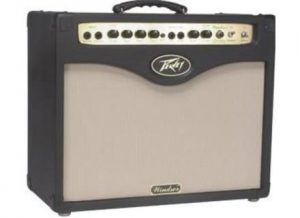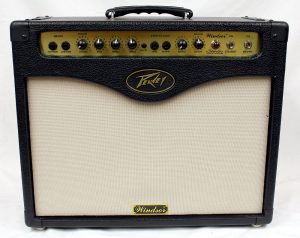Able to swamp output valves and with a built-in power soak, the Peavey Windsor Studio is one of the hottest affordable home/recording/small gig amps out there. Peavey introduced the Windsor range in 2006 with a name, as well as a look to the cabinet Peavey Windsor Studiodesign. That suggested a British amplifier influence. A trend that has recently been reflected by many other US amp makers. The Windsor Studio also addresses a new market area for Peavey. Where sound quality and recording-friendly power arrangements dominate and high volume ability is a minor consideration.

Features
Table of Contents
The quality of sound and the volume at which it can be reached is embodied in two important features. Firstly, is a cathode-biased single-ended power stage, while the second is a passive speaker attenuator comprising a big wire-wound pot, capable of handling the amp’s entire output if necessary. Slung underneath the chassis. Secondly, this permits the speaker to be fed any desired proportion of the output, down to and including zero. Valves being what they are, the unwanted power has to be dispersed somewhere. And the pot certainly looks and feels chunky enough to cope with that.
Another useful capability is that the amp can be fitted with, and will adjust itself to, any of the wide choice of output valves that have octal pin-outs, notably 6L6GC, KT66, and EL34. The sonic signature in overdrive will reflect the character of whatever is chosen and thus widen the Windsor’s tonal range. Normally this is a once-only choice, most players finding a preference and sticking with it, but it’s useful for exploration too, and a single-ended design reveals more of the valves’ individual sonic signature than the usual push-pull two-valve type.

These are the most prominent features of the Windsor, but other aspects aren’t negligible. The Volume/Master setup, Boost selector (approximately a tone-stack defeat), and transformer-coupled recording outlet provide yet more choice of tone colour and recording method. The onboard reverb is useful for making early decisions in any reverb-or-no-reverb discussion. Even if, in the event, some other method is used.
Sounds
The build has a hybrid feel, with a solidly-made cabinet of 18mm MDF enclosing a relatively delicate steel chassis. The speaker cloth in particular belying its fine appearance with a firm resistance to the finger-poke test. And the cute matt gold control panel and knobs are recessed enough for good protection. The chassis itself has no big weights to support so with its multi-point fixings it’s entirely up to its job – after all, this isn’t a first-call backline touring amp. Internally, everything’s on one big board, with key components a little tougher-looking than the average at this price level. Some of the resistors and coupling caps would be at home in a high-end handbuilt. Although the price limits are clearer from the pots and jacks. The jewel pilot isn’t an expensive filament bulb but, cleverly, a board-mounted red LED.
Peavey Windsor Studio Specifications & Features
Description: 20W 1×12″ all-valve combo with reverb
RRP: £292
Specs: 12″ Blue Marvel speaker, 10″ spring reverb
Front panel: High gain/Low gain jacks; Volume, Bass, Middle, Treble controls; Boost selector; Send/Return jacks (series-wired line level); Reverb control; Master volume control; Jewel pilot; Standby; Power.
Rear panel: IEC mains socket; paired speaker jacks; 4/8/16 Ohm impedance selector; balanced recording output (Cannon) jack with ground lift; remote switch jack for 2-function (Effects Loop, Boost) footswitch. Power Sponge speaker attenuator under chassis
Others in range: Windsor 120 head and 4×12″ cabinet
Dimensions: 54cm wide, 47cm high, 26cm deep
Weight: 16kg/36lbs
Accessories: Footswitch (optional), slipcover (optional)
Contact: Peavey UK
01536 461234

Leave a Reply
You must be logged in to post a comment.